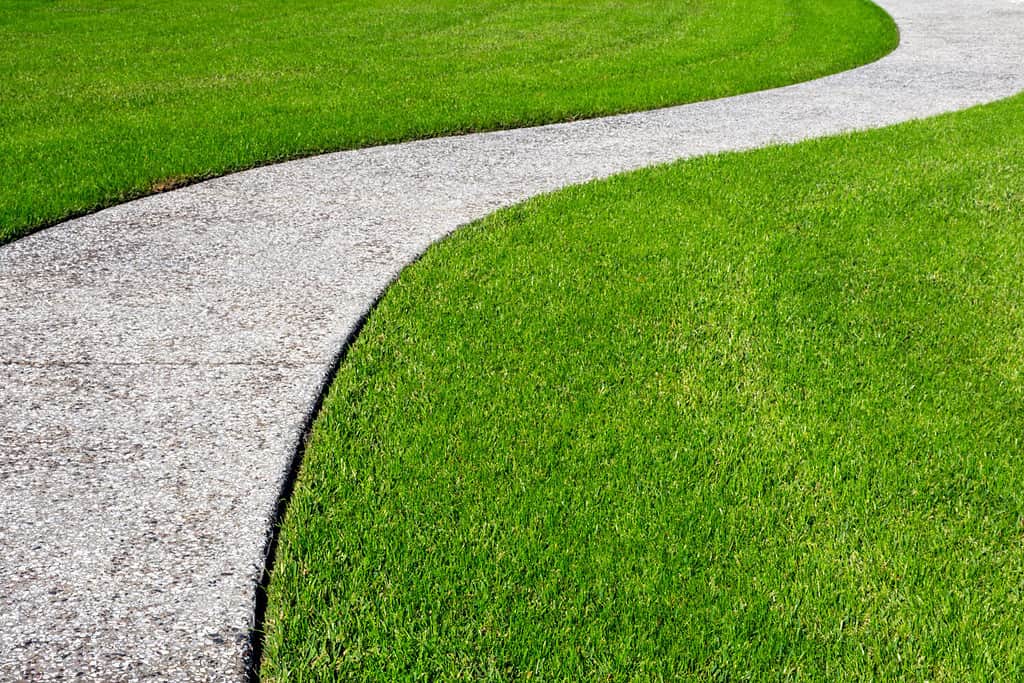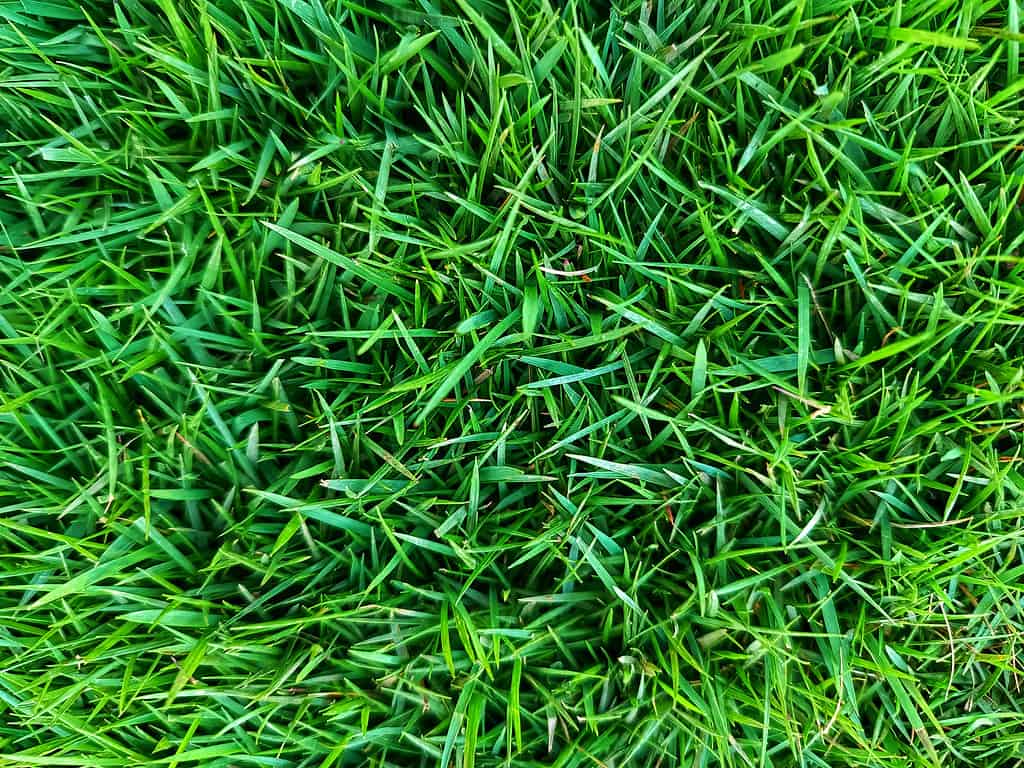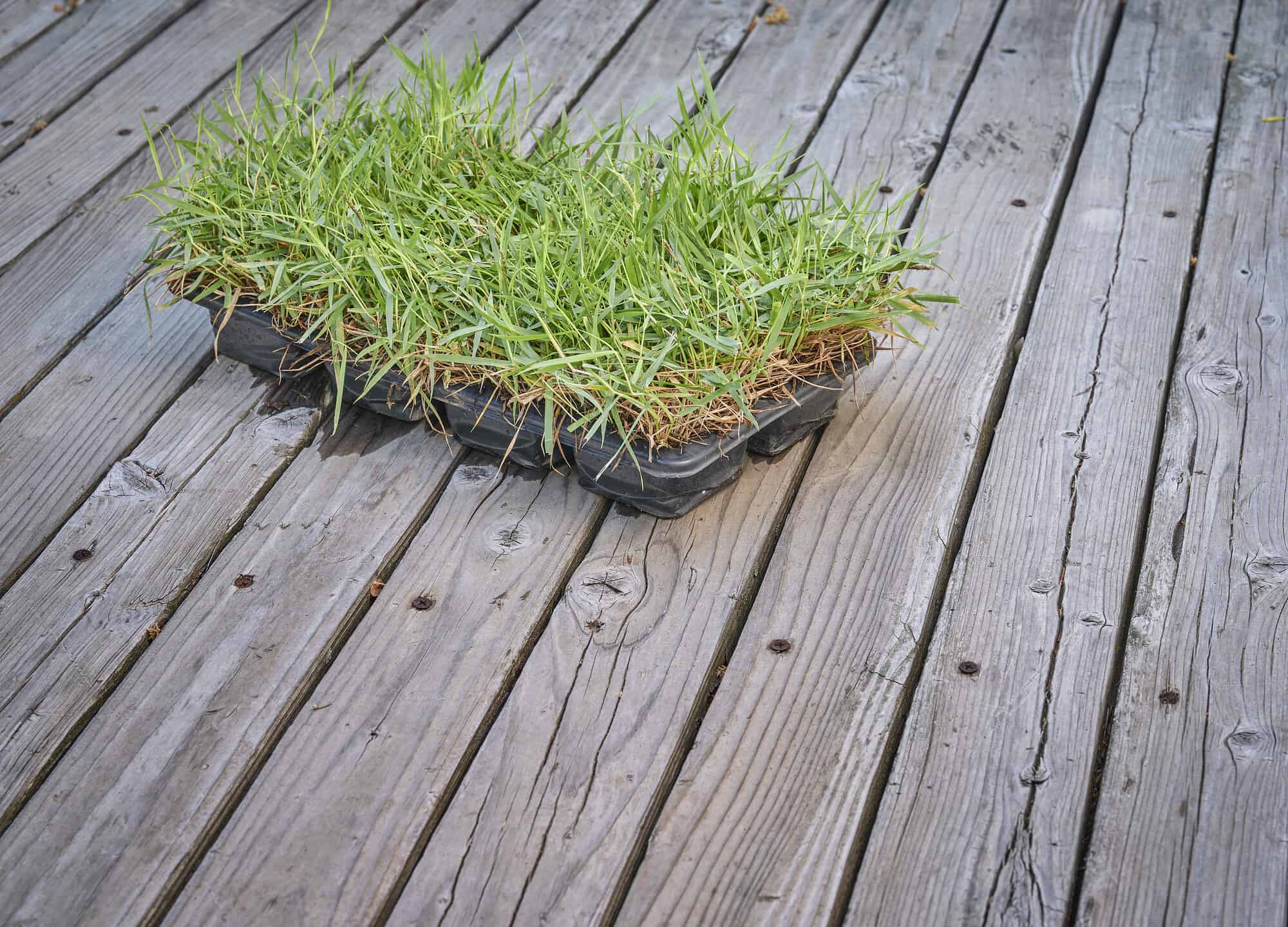Over the past few decades, Zoysia grass has become extremely popular thanks to its ability to spread through an area simply by planting Zoysia plugs. This is much less hassle than reseeding an entire yard, which is what you would have to do with other traditional lawn grasses. So, if you want a beautiful green lawn but don’t have the time or patience to plant one from scratch, Zoysia plugs might be the option for you.

Zoysia grass makes a thick carpet.
©Joanne Dale/Shutterstock.com
What Is Zoysia Grass?
Zoysia grass is a turfgrass light green in color. Therefore, it is a popular warm-season grass used for commercial and residential purposes. It usually thrives in temperatures between 80 to 90 degrees Fahrenheit but will become dormant if it gets colder than 55 degrees. As a result, it is ideal for areas with longer summers and short, mild winters. While this grass goes brown when dormant, it survives winter and starts to grow again as the climate gets warmer.
Furthermore, Zoysia grass is dense and hardy, meaning it can handle a lot of foot traffic. In addition, it is drought and partially shade tolerant. Lastly, it has a thick stolon-based root system and outcompetes many weeds.
Three Types of Zoysia Grass
Zoysia grass comes in three different types, including:
Zoysia Matrella
This grass is also known as Manila grass, and its leaves are much finer and have a denser look than tenuifolia and japonica. However, it needs more maintenance than the other two types of grass. Furthermore, it is less tolerant of cold and grows slower. Zoysia matrella has several varieties, including Zeon and Diamond.

Zoyzia Matrella grass or commonly called Manila grass
©iStock.com/HendSTD
Zoysia Japonica
This type of Zoysia grass is the most widely used species available. Zoysia japonica is also known as Korean or Japanese lawn grass. It is the fastest-growing type of Zoysia and has the highest tolerance for drought and cold. Furthermore, its varieties include Zenith, El Toro, and Meyer Zoysia.

©Yanti Lin/Shutterstock.com
Zoysia Tenuifolia
Also known as Korean velvet grass, Zoysia tenuifolia has a delicate, soft texture and usually grows in mounds or clumps instead of a smooth lawn formation. It isn’t the most popular type as it has a slower growth rate compared to other Zoysia species. Therefore, it is best suited as a small ornamental plant. There are several varieties of Zoysia tenuifolia, the most common being Emerald Zoysia.

Zoysia tenuifolia has a delicate, soft texture and usually grows in mounds or clumps instead of a smooth lawn formation.
©NANCY AYUMI KUNIHIRO/Shutterstock.com
Planting Zoysia Grass Plugs
When planting Zoysia grass plugs, you need to follow a guide for the best results. So, here are some tips to help you transform your garden:
Get the Mower Out
Before planting your Zoysia grass plugs, mow your lawn as low as possible. This rule only applies if you are planting plugs in an area that already has some lawn. Use the lowest blade height setting. Generally, mowers can cut down to one inch, but the lower, the better.
Wet the Ground
It is important to moisten the ground before planting the plugs, but only if the area is dry. By watering the area, you are making it easier to dig and plant. In addition, plants have a hard time thriving in dry, hard ground.
Water the Sod Sheet
When you purchase Zoysia grass plugs, they will come in a sheet of sod consisting of several small containers which you can cut apart. Before planting them, water the sod sheet and ensure the plugs’ roots are wet. Keeping the plugs moist will make it easier to cut them apart and keep the Zoysia healthy while you prepare the plant.
Cut the Sod Sheet
Using the sharpest shears you have, cut the sod sheet into one to two-inch plugs. Cutting them any bigger will speed up the planting process as there will be fewer plugs to plant. But, if you keep them small, your lawn will grow thicker as you can plant the plugs closer together.
Spacing
Once you are ready to plant your plugs, measure the holes 4 to 12 inches apart. You can decide how far apart you want to plant them. For example, planting the plugs close together will make the grass spread quicker. Furthermore, dig the holes 4 to 6 inches apart if you want a thicker lawn. For a sparser covering, dig the holes 7 to 12 inches apart.
Dig Holes
Once you have your spacing figured out, you can begin to dig the holes for your Zoysia grass plugs. Tools like a garden trowel, auger, or step-on plugger will create the best holes. Each one needs to be at least 1 inch wider and deeper than the grass plug in order to provide enough space to fill in with loose soil. The best tool is the step-on plugger, as it cuts a plug-sized chuck in the ground.
Water Each Hole
Before planting the plugs, water each hole and refill it slightly with loose dirt. Then, take a garden hose and fill the holes with around an inch of water, as the Zoysia grass plugs need moisture to establish their roots. Furthermore, add an inch of loose soil to the hole so the plug has something soft to sit on.
Plant Zoysia Grass Plugs
Finally, you can start to plant the plugs. Once you have placed the plugs in their holes, fill them with loose soil until their roots are covered. If you cover the entire plug with soil, it will not be able to grow properly. Next, take your hands or feet and press down firmly on each plug. This fills in any space between the roots of the plug and the soil. The roots need to have contact with the soil to establish themselves.
Water the Plugs
The Zoysia grass plugs need 15 minutes of gentle watering for the first three weeks. It is of utmost importance to use a gentle stream while watering the plugs as they are delicate and damage easily. However, don’t water your lawn all at once; separate it into short intervals so the water has time to soak into the ground instead of running off.
Don’t Mow the Lawn
You need to wait at least 30 days after planting your Zoysia grass plugs before mowing the lawn. Allowing the plugs to grow without disruption helps the roots establish, increasing the chances of survival.
Apply Fertilizer
Wait one to two weeks before applying turf fertilizer to your plugs, providing them with the nutrients to help them thrive. Fertilizer is available at any gardening store or online; choose a balanced 10-10-10 mix or turf fertilizer. Additionally, you need to fertilize your plugs every four to six weeks during the growing season after planting.
Stay Away From Chemical Weed Control
Stay away from any pesticides for at least 45 days after planting your plugs. Chemicals can harm these delicate young plants, causing stunted growth or death.
Five Tips for Maintaining a Zoysia Lawn
Maintaining Zoysia grass plugs after planting is time-consuming, but this grass is relatively low-maintenance once established. Basic care requirements include:
- One inch of water a week
- Mowing every 7 to 10 days
- Fertilize with a 1-2-1 fertilizer routinely throughout the growing season
- Using a dethatching rake or vertical mower, dethatch your lawn once a year
- Keep an eye out for diseases or pests. To prevent fungal diseases, keep the thatch layer at half an inch and avoid watering in the evening.
Zoysia Grass Plugs: Does It Really Work?
Yes, Zoysia grass really works. However, it takes a lot of effort to get it established. Firstly, you need to ensure it is planted correctly, and then you have to water, fertilize, and mow the lawn regularly to help it thrive. But, all the hard work is worth it, leaving you with a lush, dense light green lawn.
Thank you for reading! Have some feedback for us? Contact the AZ Animals editorial team.








